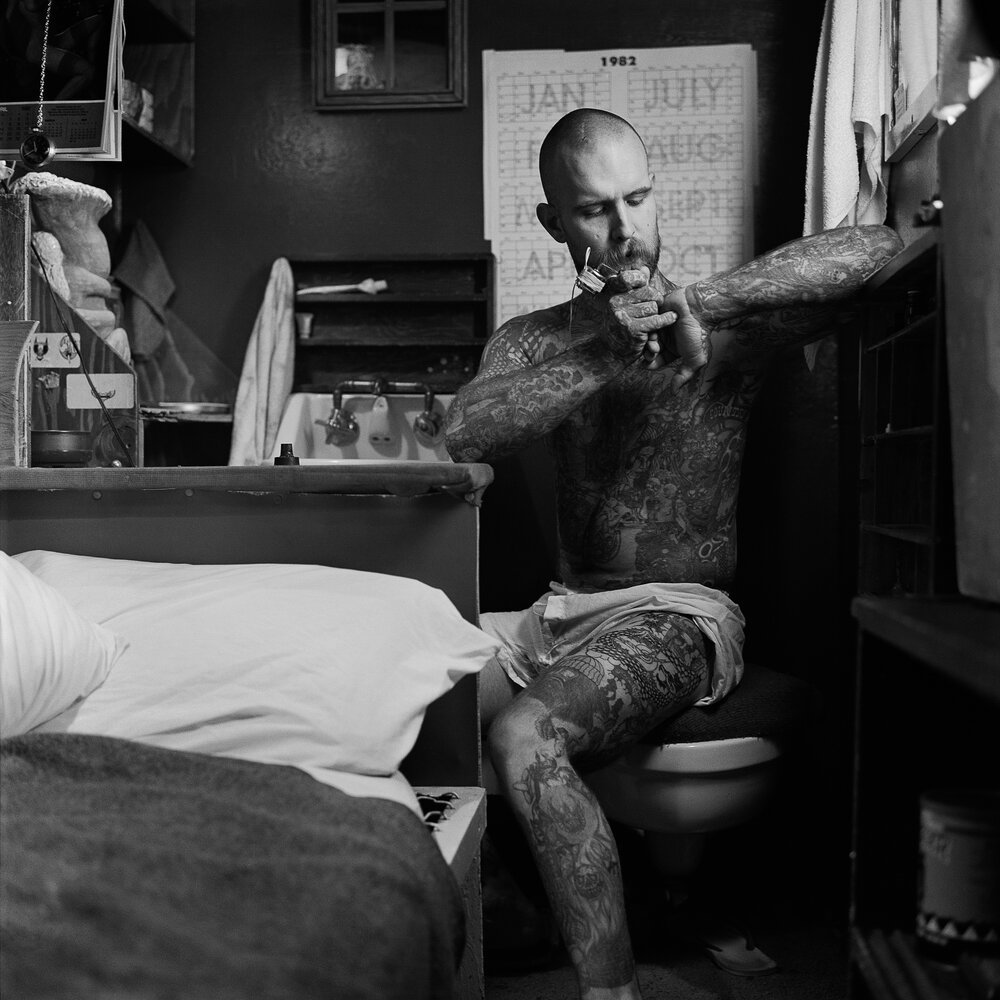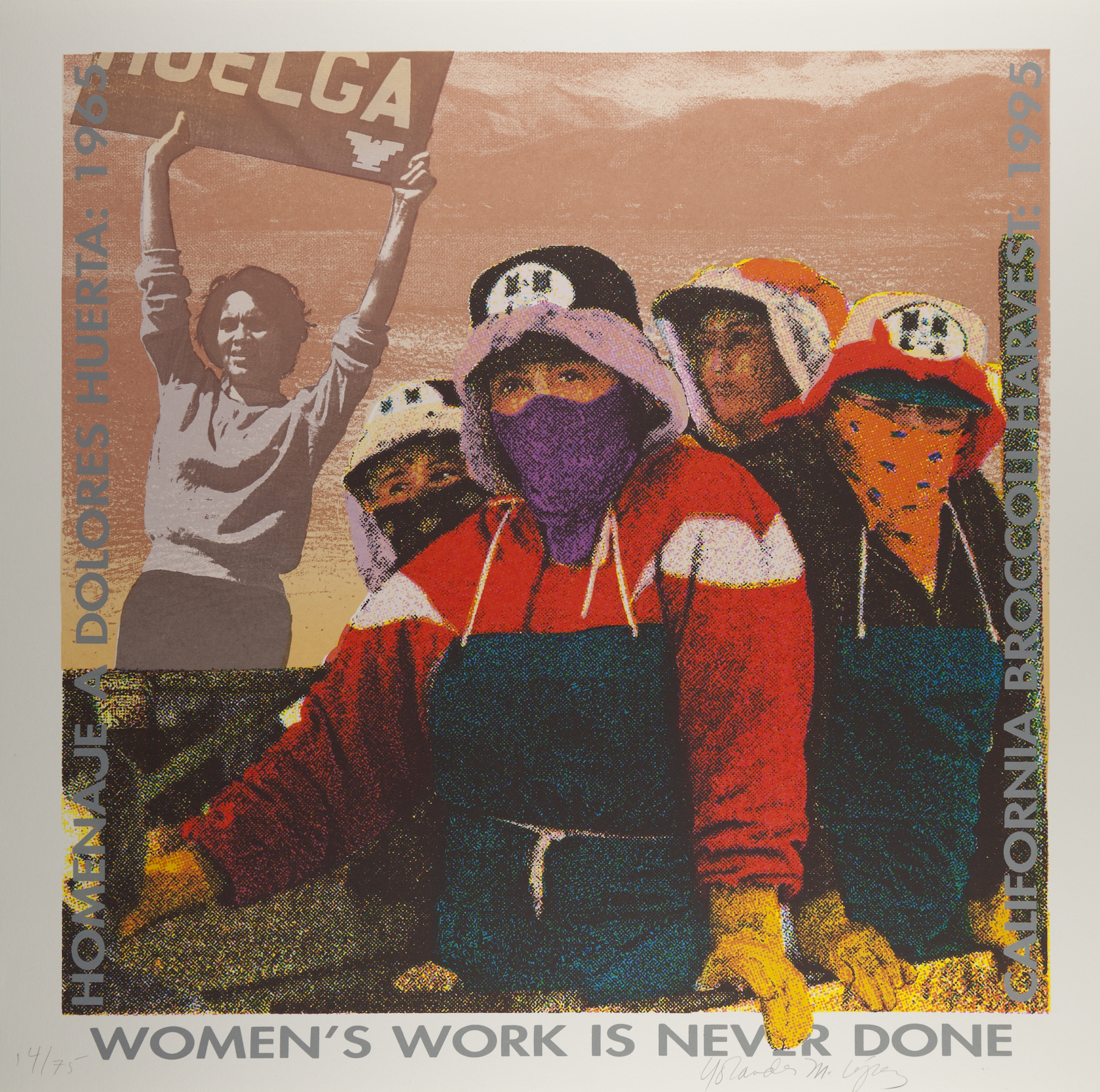III. Percenda: An Exploration of Strength and Power
- Sydney Pearce
 Figure 11
Figure 11
Percenda, a three-color silkscreen print from the portfolio 10x10: Ten Women/Ten Prints created in 1995, is a bold form of representation within this exhibition (fig. 11). Ruth Morgan illustrates the strength and power present in young people and the potential that they hold. Morgan, a portrait photographer, captures the essence of a young girl facing all of the systems that oppress her with dignity and fortitude. Through this print, Morgan explores the dynamics of racism, sexism, and poverty through the eyes of a teenage girl, illuminating the struggles and pressure to overcome the systems that many marginalized people experience throughout their lifetimes.
 Figure 12
Figure 12
Ruth Morgan is an active portrait photographer who has explored different marginalized communities, their impact on the world around them, and the conditions they must endure. She has predominantly worked with incarcerated individuals, especially those detained in San Quentin State Prison and the San Francisco County Jail (fig. 12). Within her portfolios, she shows these detained men in their inhumane conditions, trying to live their lives to the fullest. From the late 1970s to the mid-1980s, she has documented these men and exhibited their photos in order to illuminate the hostile and inhumane conditions present within the prisons.1 Within these institutions, she was granted incredible access to the lives of the prisoners and was granted the opportunity to give photography lessons to the men held there. Additionally, she became the director of the non-profit organization Community Works in 1994, a restorative justice program focused on the arts in San Francisco. This program helps to empower teenagers and adults alike, whether or not they have been to prison or kept in some sort of detention facility. Community Works’ mission states that their “continuum of services is designed to meet the needs of people at any stage of justice system involvement” while their practices and programs are “culturally responsive, trauma-informed, and rooted in Restorative Justice and the Arts.”2
 Figure 13
Figure 13
Along with incarcerated individuals, Morgan also explores the lives and traditions of different Indigenous peoples, such as the Ohlone of the Bay Area and the Piqua Shawnee of the Ohio Valley. With the Piqua Shawnee portfolio, Morgan explores how these people interact with nearby conflicting cultures and the reclamation and revitalization of the Native culture (fig. 13). These explorations into the various cultures of Native people and how they interact with the larger society have toured all around the world in exhibitions and publications.
 Figure 14
Figure 14
Percenda is an example of some of the work she has completed showing the lives of homeless and impoverished young people in New York City. The print was derived from the original photo exhibited in a portfolio created by the Berkeley Art Center and Alliance Graphics entitled 10x10: Ten Women/Ten Prints. This portfolio and exhibition celebrated the 75th anniversary of women’s suffrage and the passing of the 19th Amendment to the United States Constitution by commissioning ten women artists to explore what it means to be a woman in the modern era and the complications that come with that identity.3 Many additional works in this exhibition have been gathered from this portfolio, such as Yolanda M. López’s Women’s Work is Never Done (fig. 14), and Kim Anno’s Eve. These works explore the diverse experiences of women who are part of different cultures and experience different aspects of sexism and oppression. Some artists explore the daily lives of women, while some take a more conceptual and idealized version of womanhood and femininity. Each of the works takes a different approach and point of view to their interpretation of the meaning of womanhood in the last 30 years.
As one of the pieces used to explore womanhood and femininity, Percenda displays the strength and resistance of marginalized young people. Within the frame, a young girl stands at the center of the composition, her eyes focused directly to the camera and arms crossed in defiance. Her gaze is sad yet set in determination; she knows of the hardships she endures and will have to endure in the future, yet she remains resolute. As a young African American girl, she will have to face racism, sexism, and many other forms of systematic oppression designed to keep her in the position she is: an impoverished and powerless person. She subverts this expectation of powerlessness with her resolute stance and crossed arms, showing the viewers that she will not be ignored or stepped over, she must be acknowledged within the frame and within our minds. She stands in front of a blackboard, with a grammar lesson on the uses of the prefixes un- and dis-, commonly used to transform words into their opposite meaning. This signifies the way young people look at the world. The Ulrich Museum of Art interprets this lesson to hold “symbolic weight for a child who has experienced unfair or unkind treatment.”4 For a young Black student, school may serve as the only outlet for growth and advancement within society, a sort of safe space of expression and creativity within the bounds of expectations. Percenda stands here illuminating her sense of belonging and ownership over her classroom, she isn’t afraid to confront the viewer directly and challenge them to reevaluate what they believe is possible for this young girl.
Within this virtual exhibition, Shifting Perspectives, the curators focus on ideas of resistance, identity, and culture presented through art. Many works that are shown alongside Percenda display the unique experiences of people of color, queer people, and women and how they interpret the world around them and interact with their culture. Many of these works are directly facing the oppression placed against them by those in power by subverting expectations, using biting political commentary, or through more subtle conceptual ideas of resistance. Percenda by Ruth Morgan shows the power within young African Americans and their strength as they fight against those that seek to keep them in their place, especially young Black women and their fight for equality, present throughout the history of this country and up until today.
- Ruth Morgan, “San Quentin: Maximum Security 1981-1983,” Ruth Morgan Photography, 2008, https://www.ruthmorganphotography.com/san-quentin. Accessed 3 November 2020. ↩
- Community Works, “The Issue,” Community Works: Justice Demands Humanity, 2016,
http://communityworkswest.org/what-we-do/the-issue/. Accessed 3 November 2020. ↩ - Robbin L. Henderson, “10x10: Ten Women / Ten Prints,” Berkeley Art Center, https://www.berkeleyartcenter.org/10-x-10?rq=ten%20women%2Ften%20prints. Accessed 3 November 2020. ↩
- Nellie, Elliot, “Percenda,” Ulrich Museum of Art, 1 July 2020, https://ulrich.wichita.edu/ulrich_art_item/percenda/?collection_type=exhibition&collection_id=2004. Accessed 3 November 2020. ↩